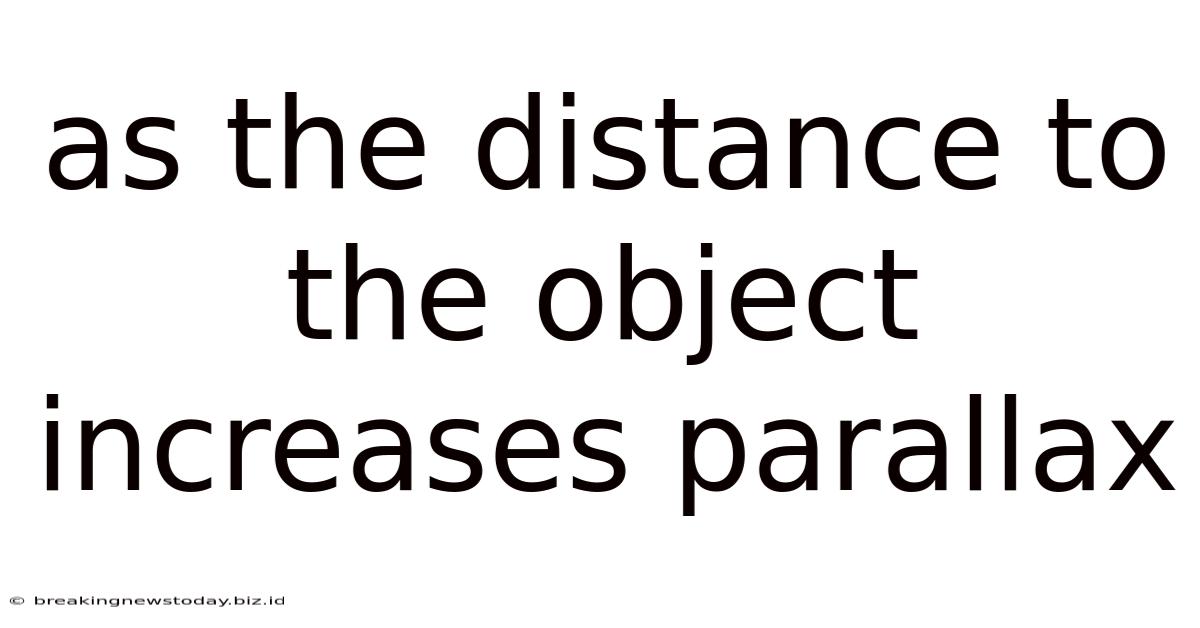As The Distance To The Object Increases Parallax
Breaking News Today
May 12, 2025 · 5 min read

Table of Contents
As the Distance to the Object Increases, Parallax Decreases: A Deep Dive into Stellar Distances
Parallax, a seemingly simple concept in geometry, plays a crucial role in astronomy, serving as a fundamental method for measuring the distances to nearby stars. Understanding how parallax changes with distance is key to grasping the vast scales of the universe and the challenges astronomers face in exploring its furthest reaches. This article delves into the intricacies of parallax, exploring its relationship with distance, the limitations of the method, and its essential role in establishing the cosmic distance ladder.
Understanding Parallax: The Angle of Apparent Shift
Parallax is the apparent shift in the position of an object when viewed from different locations. Imagine holding your finger out at arm's length and closing one eye, then the other. Your finger appears to shift against the background. This apparent shift is parallax. In astronomy, we use the Earth's orbit around the Sun as our two viewing points.
The Baseline: Earth's Orbital Diameter
The crucial element in parallax measurement is the baseline, the distance between the two observation points. In astronomy, this baseline is the diameter of Earth's orbit around the Sun, approximately 300 million kilometers (186 million miles). This vast distance provides the necessary separation to detect the minuscule shifts in the positions of even the nearest stars.
Measuring the Angle: Arcseconds
The apparent shift, or parallax angle, is incredibly small. It's typically measured in arcseconds, a unit of angular measurement equal to 1/3600 of a degree. Even the closest stars exhibit parallax angles of less than one arcsecond. This minuscule shift necessitates incredibly precise measurements, showcasing the remarkable advancements in astronomical instrumentation.
The Inverse Relationship: Distance and Parallax Angle
The key relationship between parallax angle (p) and distance (d) is inversely proportional. This means that as the distance to an object increases, the parallax angle decreases. This relationship can be expressed mathematically as:
d = 1/p
Where:
- d is the distance to the star in parsecs.
- p is the parallax angle in arcseconds.
A parsec, a unit of distance commonly used in astronomy, is defined as the distance at which a star would have a parallax angle of one arcsecond. One parsec is approximately 3.26 light-years.
Illustrative Examples:
- A star with a parallax angle of 0.5 arcseconds is 2 parsecs away. (d = 1/0.5 = 2 parsecs)
- A star with a parallax angle of 0.1 arcseconds is 10 parsecs away. (d = 1/0.1 = 10 parsecs)
- A star with a parallax angle of 0.01 arcseconds is 100 parsecs away. (d = 1/0.01 = 100 parsecs)
This inverse relationship clearly demonstrates that as the distance increases, the parallax angle shrinks dramatically, making precise measurements increasingly challenging.
Limitations of Parallax Measurements: Reaching the Cosmic Horizon
While parallax is a powerful technique, its effectiveness is limited by the size of the baseline and the precision of our measuring instruments. The smaller the parallax angle, the more difficult it becomes to measure accurately.
Instrumental Precision: The Role of Technology
The precision of parallax measurements relies heavily on advancements in astronomical technology. High-precision telescopes and sophisticated techniques like interferometry are essential for detecting and measuring these minuscule angular shifts. Advances in technology continue to push the limits of parallax measurements, allowing astronomers to probe ever-greater distances.
The Distance Limit: Beyond a Few Hundred Parsecs
Parallax measurements become increasingly difficult and unreliable beyond a few hundred parsecs. The parallax angles become so incredibly small that they are often obscured by atmospheric effects and instrumental limitations. Beyond this distance, astronomers rely on other methods to measure distances, forming the basis of the cosmic distance ladder.
The Cosmic Distance Ladder: Building Upon Parallax
Parallax provides the fundamental rung of the cosmic distance ladder, a sequence of techniques used to measure distances across the vast expanse of the universe. Because parallax's range is limited, astronomers utilize other methods to measure greater distances, each method calibrated and verified using the more accurate, nearer methods.
Standard Candles: Cepheid Variables and Type Ia Supernovae
Beyond the reach of parallax, astronomers rely on standard candles, objects with known intrinsic luminosity. By comparing their apparent brightness to their known luminosity, astronomers can calculate their distance. Cepheid variable stars and Type Ia supernovae are two prominent examples of standard candles, extending the reach of distance measurements far beyond what's possible with parallax alone.
Redshift and Hubble's Law: Mapping the Expanding Universe
At the largest distances, the redshift of galaxies – the stretching of light wavelengths due to the expansion of the universe – provides a crucial means of estimating distance. Hubble's Law, which relates redshift to distance, is fundamental in mapping the vastness of the observable universe, relying on the foundational distance measurements provided by parallax and standard candles.
Conclusion: Parallax – A Cornerstone of Cosmic Cartography
Parallax, despite its limitations, remains a cornerstone of astronomical distance measurement. Its direct and geometric nature provides an essential foundation for calibrating other distance measurement techniques. Understanding the inverse relationship between distance and parallax angle is crucial for comprehending the challenges and triumphs of exploring the vast distances of the cosmos. As technology continues to advance, our ability to use parallax and other techniques to map the universe will continue to improve, revealing more of the universe's secrets. The seemingly simple concept of parallax, therefore, underpins our understanding of the universe's incredible scale and the ongoing quest to chart its far reaches.
Latest Posts
Related Post
Thank you for visiting our website which covers about As The Distance To The Object Increases Parallax . We hope the information provided has been useful to you. Feel free to contact us if you have any questions or need further assistance. See you next time and don't miss to bookmark.